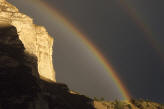Denali provides one of the few
intact and naturally regulated subarctic ecosystems in the world because
of its long history and substantial size. Landscape scale processes such
as fire, succession, and outbreaks of disease have not been significantly
altered by human intervention. These components and processes of the
system are still responding naturally to other primary processes such as
weather or geologic events.
The high mountains of the Alaska
Range shelter the Alaskan interior from the moist maritime air from the
Gulf of Alaska creating two distinct climatic regimes within the park.
South of the Alaska Range you find a warmer, moister transitional maritime
zone and north of the range you find a drier continental zone where
winters cold and long, and summers are warm and short. The high latitude
and varying altitude within the park strongly influences plant growth, the
presence and composition of forests, and the presence and extent of
permafrost.
Across the largely treeless
expanse of the park, the views are of a scale unknown in the lower 48
states. Denali is the only Class I air quality area of significant size in
Alaska, which under the Clean Air Act was set aside to receive the most
stringent degree of air quality protection. On a clear day, Mt McKinley
can easily be seen from Anchorage, more than 130 air miles to the south.
Outstanding views of natural features dominate the landscape and are
internationally known.
Natural wildfires, mostly caused
by lightning, are a critical component of the boreal forest ecosystem.
Fires of considerable size and intensity are common north of the Alaska
Range. A complex fire history has created a patchwork landscape of
vegetation communities of different species and ages. The habitat and life
cycles of many plants and animals rely on the rejuvenating process of
fire. These communities have adapted to fires that have been occurring on
this landscape for the past ten thousand years.
Denali National Park and Preserve
offers a unique subarctic environment to study climate, glaciers, geologic
processes, and fire ecology. The role of humans and human-induced changes
such as air and water pollution are monitored as well. Everything we do
affects the park in ways both great and small; from transcontinental air
pollution, to the non-native species we introduce from seeds carried on
the soles of our shoes, to our efforts at preservation. Park scientists
and managers continuously monitor the natural environment to assess these
impacts in order to protect the natural resources of the park.

